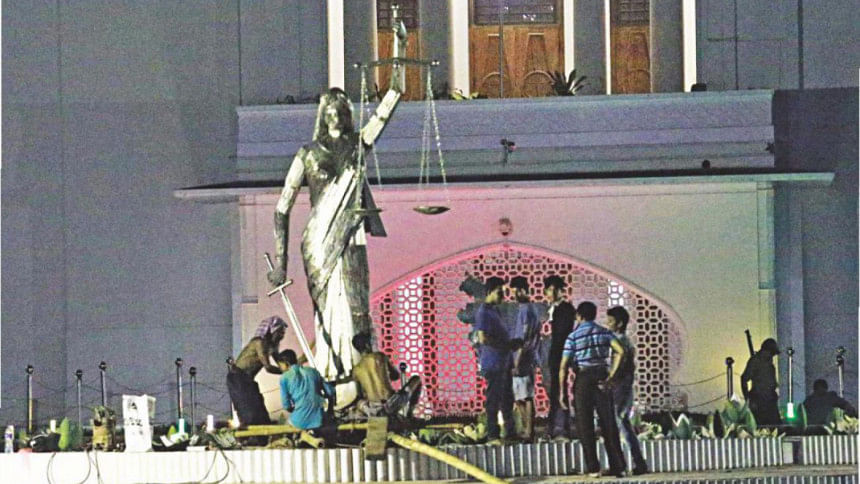Taking down the "Symbol of Justice"

Finally, the Goddess of Themis had to step down. And she had to do so unceremoniously, under duress. Earlier, the elders of the Supreme Court opined that Themis had to vacate her position "to avert any untoward situation".
Earlier, on February 24, 2017 supporters of Hefazat-e-Islam marched from the national mosque and submitted a petition to the Supreme Court (SC) to demolish it. They were supported by the Awami League affiliate Bangladesh Awami Olema League. They called the work of art as conspiracy to undermine Islam in Bangladesh. On April 11 at a meeting with the leadership of various factions of the Qwami madrasas at Ganabhaban the Prime Minister observed that she personally did not like the statue on the SC premises either. The premier promised to discuss the matter with the chief justice and urged the Alem-Ulema to have patience. Subsequently she informed her cabinet colleagues that she had asked the chief justice either to remove the statue or reinstall it at another place so that it cannot be seen from the National Eidgah. On April 21, Islami Andolan Bangladesh gave an ultimatum to the government for removal of the statue before Ramadan.
The removal of the statue is a victory for the religious right. Stoking extremist views Hefazat, Awami Ulema League, Islamic Andolon and their cohorts claimed that Dhaka the 'city of mosques' has now been turned into a 'city of idols'. For them the statue of Themis (holding a sword and scales that is almost universally acknowledged as dispensation of fair justice) amounts to idolatry."Statues or any kind of idols are completely banned in Islam", they reckon."There is no place for a statue in our religion. So "Muslims can't allow a statue in the Supreme Court premises".
Liberals are appalled that the authorities have caved in to the pressure. They acknowledge that the SC could do little as the executive arm had already committed itself to its removal. Keeping the sculpture at the present site in all likelihood might have triggered violence and mayhem.
Discerning observers view this episode as a logical corollary to the government's all out effort to placate the religious right. The action is consistent with the government's earlier decisions to sanitise the textbooks of what the Hefazat and its partners viewed as unwarranted pieces, mostly of non-Muslim authors, and by legislating the Child Marriage Restraint Act in February 2017 allowing exceptions to the minimum age for the marriage of women under 'special circumstances'. Perhaps in the same sequence of placating the religious right in late April the ECNEC had approved plans to build some 560 mosque-cum-Islamic Cultural Centres by December 2019. Press was informed that the government had already mapped out 20 acres of land for this purpose.
Observers are not surprised that the rival Bangladesh Nationalist Party mounted little opposition to these policies. In fact, it blamed the ruling party of hijacking its own incomplete agenda of recognising the Dawra degree. The left parties and intellectuals associated with that stream forthrightly condemned the government moves as blatant political opportunism, undermining the core spirit of the War of Liberation. Interestingly though, the traditional champions of the spirit of the War of Liberation and the much coveted and decorated 'guardians of national conscience' remained disturbingly muted. In television talk shows some even went an extra length and justified the government's move as "only a move to bring BNP pawns to our own fold". Instead of challenging the government plan to remove the sculpture from the Supreme Court site on grounds of cultural freedom and pluralism, the platform of the pro-government the Shommilito Sangskritik Jote concurred with the government move. There is little doubt how diametrically opposed the response of the Jote would have been had BNP was in power now.
With the 2019 election at sight the Awami League's veering to the right and its hobnobbing with conservative elements betrays the fact that the party can no longer depend on the constituency that brought it to power eight years ago through a massive mandate. With the thriving economy and the decimated opposition why isn't the top leadership sure of counting the support of the youth and the liberals? Why is the party risking its traditional support base that resolutely disapproved BNP's stance on Jamaat?
One explanation may be: the rampant and institutionalised corruption; excesses of the law enforcement agencies (extrajudicial killings, disappearance and torture with impunity); overindulgence of those associated with the ruling party and its affiliate organisations, particularly in securing undue advantages; overt politicisation and parochialisation of the civil administration and law enforcement agencies; framing of freedom curtailing laws and regulations, and shrinking space for liberal thinking and dissent – have all contributed to the alienation of the regime to the extent that it now has to look for new allies. The traditional liberal Awami supporters now find little difference in the ideological mooring of the BNP and their own party.
While watching his own creation being dismantled from its original site, the sculptor, Mrinal Huq observed, "We have conceded defeat. It's a slap on the face of the pro-liberation, cultural and freedom-loving people of the country." he noted. His frustration resonated among millions of Bangladeshis proud of their liberal, pluralist and tolerant heritage; perhaps less among those who tread along the corridors of power.
The writer teaches at the University of Dhaka.

 For all latest news, follow The Daily Star's Google News channel.
For all latest news, follow The Daily Star's Google News channel. 



Comments